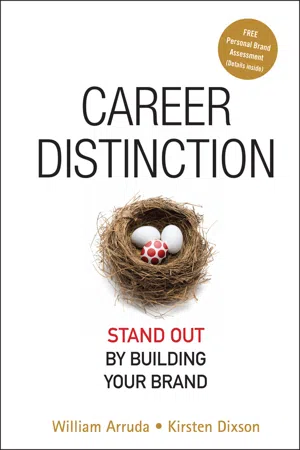
- English
- ePUB (mobile friendly)
- Available on iOS & Android
About this book
Praise for Career Distinction "Hands down, this book is the bible on branding for your career!"
-- Susan Britton Whitcomb, author of Job Search Magic "As a professional resume writer and career coach, I have extolled the concept of personal branding for my clients for years. Now, for the first time ever, I have an outstanding resource to recommend--Career Distinction by William Arruda and Kirsten Dixson. This book details the concept of personal branding in a magnificent and easy-to-digest presentation that is a must-buy for every serious job seeker."
-- Wendy S. Enelow, CCM, MRW, JCTC, CPRW Executive Director of the Career Masters Institute "Arruda and Dixson are widely respected in the global career coaching community as gurus who not only teach but live the personal branding model, and their expertise and passion show through on every page of this practical, indispensable book. I highly recommend it to all who want to distinguish themselves from the competition."
-- L. Michelle Tullier, PhD, Vice President of Right Management and author of The Unofficial Guide to Landing a Job
Frequently asked questions
- Essential is ideal for learners and professionals who enjoy exploring a wide range of subjects. Access the Essential Library with 800,000+ trusted titles and best-sellers across business, personal growth, and the humanities. Includes unlimited reading time and Standard Read Aloud voice.
- Complete: Perfect for advanced learners and researchers needing full, unrestricted access. Unlock 1.4M+ books across hundreds of subjects, including academic and specialized titles. The Complete Plan also includes advanced features like Premium Read Aloud and Research Assistant.
Please note we cannot support devices running on iOS 13 and Android 7 or earlier. Learn more about using the app.
Information
Chapter 1
Understand the Future of Work
- The factors that are impacting our careers
- What employers are really looking for
Change Is the Only Constant
Change is the law of life. And those who look only to the past or present are certain to miss the future.—John F. Kennedy, 35th President of the United States
Shrinking Job Tenure
- According to the U.S. Department of Labor, over the past few decades, the average length of time a person stays in a job in every sector of private business has decreased.1 Today, employees change their jobs every two years, their companies every three, and their industries every four.
- A 2005 ExecuNet survey revealed that corporate leaders are changing companies every 3.6 years, down from 4.1 years in 2002.2 For some occupations, the expected average tenure is even shorter. Take chief marketing officers: At the world’s top-100 branded companies, CMO tenure is just under two years, according to a 2004 Spencer Stuart survey.3 Why the revolving door? CMOs are now accountable for return on investment (ROI).
- In a project-based world, the new loyalty is to the project at hand. If the project doesn’t deliver results that directly boost the bottom line, the typical organization will cancel it—along with team members’ employment contracts. This is not a secret to most career-minded professionals: A 2006 Pew study revealed that 62 percent of Americans believe that there is less job security today than there was 20 or 30 years ago.4
Blurred Boundaries between Work and Personal Life
- With the exception of France (where the work week has been reduced), the number of hours we work each week has increased. In 1969, couples in the United States, aged 25 to 54, worked a combined 56 hours per week. By the year 2000, they were working nearly 70 hours.5
- Hotels, airports, Starbucks, and caf?have become Wi-Fi zones, making it easy for people to work from any location. Entire cities, like Philadelphia and San Jose are becoming “Wi-Fied.” And you can expect Wi-Fi on aircraft and in many public places in the coming years. Companies are starting to expect an “always-on” attitude from employees.
Accelerating Organizational Change
- Companies continue to leverage technology to ensure that information flows where it is needed. Use of technology renders geographic boundaries less important, making all organizations global and all businesses e-businesses.
- Globalization and technology advances are forcing companies to develop more fluid and complex organizational structures characterized by cross-organizational networking, alliances, and outsourcing of noncore activities to specialized agencies.
- Regulations such as the Sarbanes-Oxley Act are creating jobs in finance and corporate law, while IT jobs are being handled offshore.
- More work is done in the United States by fewer people, as evidenced by the rise in productivity. Information technology and the pressure on companies to increase shareholder value through economies of scale have driven this productivity increase.
Employees’ Growing Mobility
What Employers Really Want
Table of contents
- Cover
- Contents
- Title Page
- Copyright
- Foreword
- Preface
- Acknowledgments
- Chapter 1: Understand the Future of Work
- Chapter 2: Adopt the Career Distinction Mindset
- Chapter 3: Brand Yourself for Career Success
- Step One: EXTRACT-UNEARTH YOUR UNIQUE PROMISE OF VALUE
- Step Two: EXPRESS-COMMUNICATE YOUR BRAND TO YOUR TARGET AUDIENCE
- Step Three: EXUDE-MANAGE YOUR BRAND ENVIRONMENT
- Summary: Evolve and Resolve
- Appendix
- Index
- About the Authors
- Wiley End User License Agreement